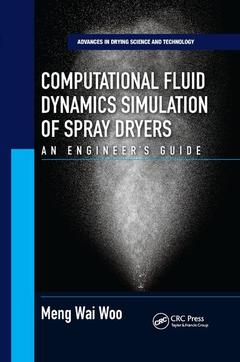Computational Fluid Dynamics Simulation of Spray Dryers An Engineer’s Guide Advances in Drying Science and Technology Series
Auteur : Woo Meng Wai

Bridging the gap in understanding between the spray drying industry and the numerical modeler on spray drying, Computational Fluid Dynamics Simulation of Spray Dryers: An Engineer?s Guide shows how to numerically capture important physical phenomena within a spray drying process using the CFD technique. It includes numerical strategies to effectively describe these phenomena, which are collated from research work and CFD industrial consultation, in particular to the dairy industry. Along with showing how to set up models, the book helps readers identify the capabilities and uncertainties of the CFD technique for spray drying. After briefly covering the basics of CFD, the book discusses airflow modeling, atomization and particle tracking, droplet drying, quality modeling, agglomeration and wall deposition modeling, and simulation validation techniques. The book also answers questions related to common challenges in industrial applications.
Introduction. Basics of CFD. Airflow Modeling. Atomization and Particle Tracking. Droplet Drying and Quality Modeling. Agglomeration and Wall Deposition Modeling. Simulation Validation Techniques. Common Challenges for Industrial Applications. Index.
Meng Wai Woo is currently a senior lecturer of chemical engineering at Monash University, Australia. His research interest is in spray drying. He has experience in computational fluid dynamics (CFD) analysis of the spray drying process and in applying this technique for industry. Within the area of spray drying, he is also examining the droplet evaporation, particle formation or interaction phenomena and in engineering the functionality of particles. Dr. Woo also explores new approaches to spray drying in introducing the antisolvent vapor precipitation approach and most recently, the narrow tube spray drying technique.
Date de parution : 12-2019
15.6x23.4 cm
Date de parution : 10-2016
15.6x23.4 cm
Thèmes de Computational Fluid Dynamics Simulation of Spray Dryers :
Mots-clés :
Cfd Simulation; Spray Drying; CFD technique; Moisture Content; drying of dairy; Spray Drying Simulation; drying of pharmaceuticals; moisture removal process; Industrial Scale Spray Dryer; Flow Field; industrial dryingdetergent manufacturingdry powders; Feed Spray Rate; Spray Chamber; food drying; Simulation Domain; dairy drying; Droplet Size Distribution; droplet drying; Steady State Simulation; agglomeration and wall deposition modeling; Pilot Scale Spray Dryer; CFD simulations; VOF Simulation; computational fluid dynamics; Single Droplet Drying; numerical strategies; Developed Flow Field; industrial drying; Transient Flow Field; Industrial Spray Dryer; Laboratory Scale Spray Dryers; Commercial Cfd Program; Drying Behavior; Central Jet; REA Approach; Time Step Size



